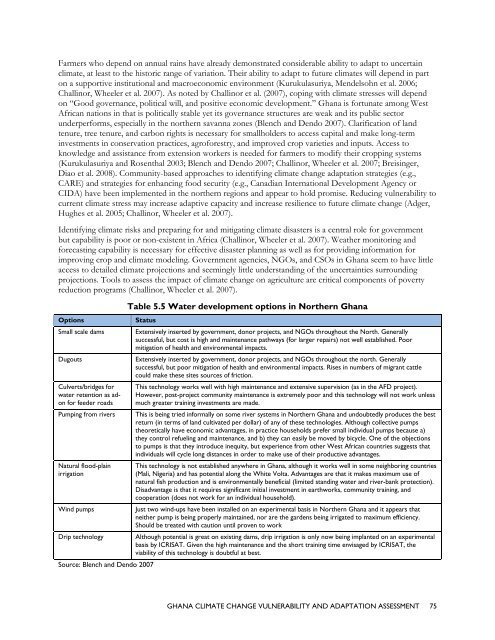ghana climate change vulnerability and adaptation assessment
ghana climate change vulnerability and adaptation assessment
ghana climate change vulnerability and adaptation assessment
- No tags were found...
Create successful ePaper yourself
Turn your PDF publications into a flip-book with our unique Google optimized e-Paper software.
Farmers who depend on annual rains have already demonstrated considerable ability to adapt to uncertain<strong>climate</strong>, at least to the historic range of variation. Their ability to adapt to future <strong>climate</strong>s will depend in parton a supportive institutional <strong>and</strong> macroeconomic environment (Kurukulasuriya, Mendelsohn et al. 2006;Challinor, Wheeler et al. 2007). As noted by Challinor et al. (2007), coping with <strong>climate</strong> stresses will dependon “Good governance, political will, <strong>and</strong> positive economic development.” Ghana is fortunate among WestAfrican nations in that is politically stable yet its governance structures are weak <strong>and</strong> its public sectorunderperforms, especially in the northern savanna zones (Blench <strong>and</strong> Dendo 2007). Clarification of l<strong>and</strong>tenure, tree tenure, <strong>and</strong> carbon rights is necessary for smallholders to access capital <strong>and</strong> make long-terminvestments in conservation practices, agroforestry, <strong>and</strong> improved crop varieties <strong>and</strong> inputs. Access toknowledge <strong>and</strong> assistance from extension workers is needed for farmers to modify their cropping systems(Kurukulasuriya <strong>and</strong> Rosenthal 2003; Blench <strong>and</strong> Dendo 2007; Challinor, Wheeler et al. 2007; Breisinger,Diao et al. 2008). Community-based approaches to identifying <strong>climate</strong> <strong>change</strong> <strong>adaptation</strong> strategies (e.g.,CARE) <strong>and</strong> strategies for enhancing food security (e.g., Canadian International Development Agency orCIDA) have been implemented in the northern regions <strong>and</strong> appear to hold promise. Reducing <strong>vulnerability</strong> tocurrent <strong>climate</strong> stress may increase adaptive capacity <strong>and</strong> increase resilience to future <strong>climate</strong> <strong>change</strong> (Adger,Hughes et al. 2005; Challinor, Wheeler et al. 2007).Identifying <strong>climate</strong> risks <strong>and</strong> preparing for <strong>and</strong> mitigating <strong>climate</strong> disasters is a central role for governmentbut capability is poor or non-existent in Africa (Challinor, Wheeler et al. 2007). Weather monitoring <strong>and</strong>forecasting capability is necessary for effective disaster planning as well as for providing information forimproving crop <strong>and</strong> <strong>climate</strong> modeling. Government agencies, NGOs, <strong>and</strong> CSOs in Ghana seem to have littleaccess to detailed <strong>climate</strong> projections <strong>and</strong> seemingly little underst<strong>and</strong>ing of the uncertainties surroundingprojections. Tools to assess the impact of <strong>climate</strong> <strong>change</strong> on agriculture are critical components of povertyreduction programs (Challinor, Wheeler et al. 2007).OptionsSmall scale damsDugoutsCulverts/bridges forwater retention as adonfor feeder roadsPumping from riversNatural flood-plainirrigationWind pumpsDrip technologySource: Blench <strong>and</strong> Dendo 2007Table 5.5 Water development options in Northern GhanaStatusExtensively inserted by government, donor projects, <strong>and</strong> NGOs throughout the North. Generallysuccessful, but cost is high <strong>and</strong> maintenance pathways (for larger repairs) not well established. Poormitigation of health <strong>and</strong> environmental impacts.Extensively inserted by government, donor projects, <strong>and</strong> NGOs throughout the north. Generallysuccessful, but poor mitigation of health <strong>and</strong> environmental impacts. Rises in numbers of migrant cattlecould make these sites sources of friction.This technology works well with high maintenance <strong>and</strong> extensive supervision (as in the AFD project).However, post-project community maintenance is extremely poor <strong>and</strong> this technology will not work unlessmuch greater training investments are made.This is being tried informally on some river systems in Northern Ghana <strong>and</strong> undoubtedly produces the bestreturn (in terms of l<strong>and</strong> cultivated per dollar) of any of these technologies. Although collective pumpstheoretically have economic advantages, in practice households prefer small individual pumps because a)they control refueling <strong>and</strong> maintenance, <strong>and</strong> b) they can easily be moved by bicycle. One of the objectionsto pumps is that they introduce inequity, but experience from other West African countries suggests thatindividuals will cycle long distances in order to make use of their productive advantages.This technology is not established anywhere in Ghana, although it works well in some neighboring countries(Mali, Nigeria) <strong>and</strong> has potential along the White Volta. Advantages are that it makes maximum use ofnatural fish production <strong>and</strong> is environmentally beneficial (limited st<strong>and</strong>ing water <strong>and</strong> river-bank protection).Disadvantage is that it requires significant initial investment in earthworks, community training, <strong>and</strong>cooperation (does not work for an individual household).Just two wind-ups have been installed on an experimental basis in Northern Ghana <strong>and</strong> it appears thatneither pump is being properly maintained, nor are the gardens being irrigated to maximum efficiency.Should be treated with caution until proven to workAlthough potential is great on existing dams, drip irrigation is only now being implanted on an experimentalbasis by ICRISAT. Given the high maintenance <strong>and</strong> the short training time envisaged by ICRISAT, theviability of this technology is doubtful at best.GHANA CLIMATE CHANGE VULNERABILITY AND ADAPTATION ASSESSMENT 75
















